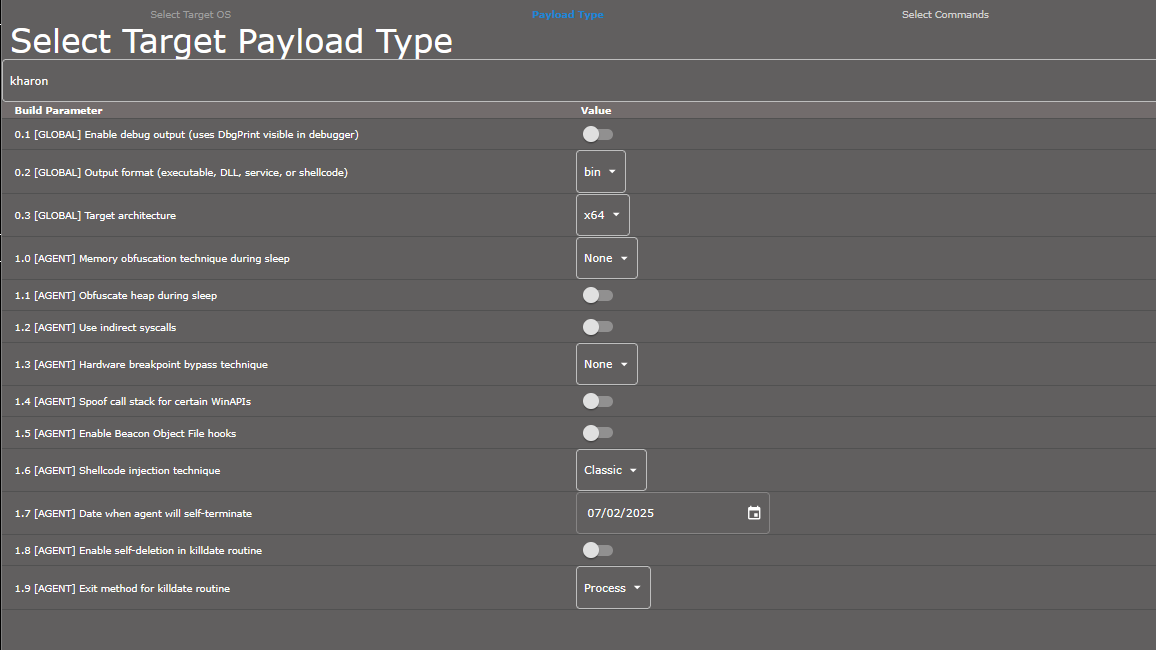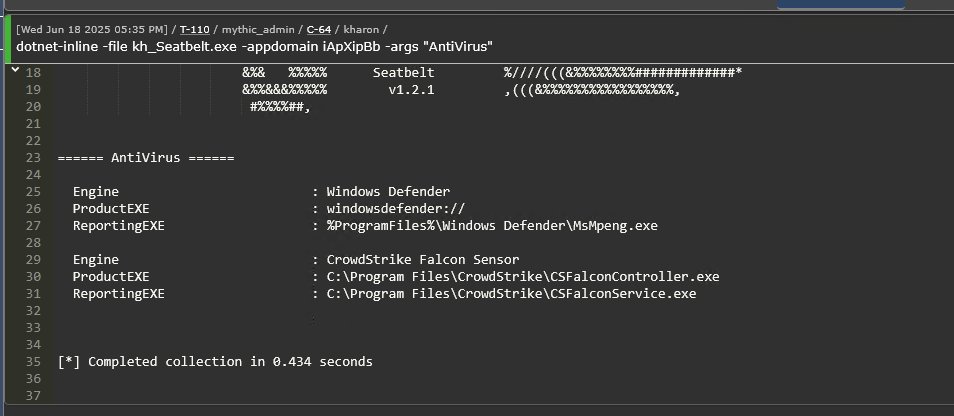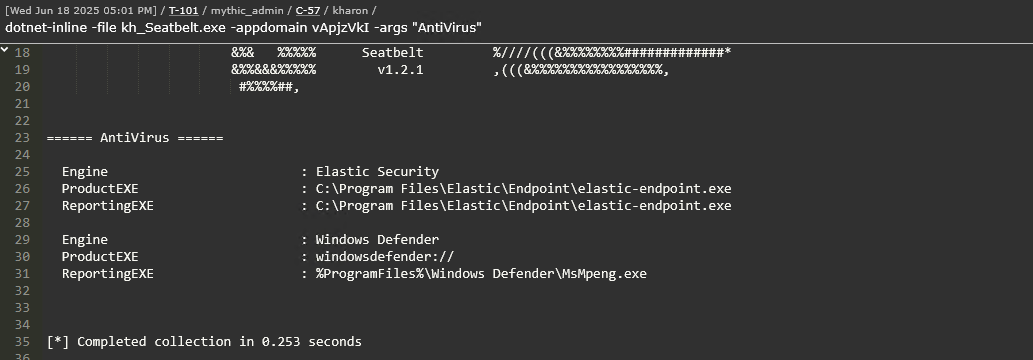Kharon Agent: Demonstration of Advanced Post-Exploitation
Presentation of my new project of an agent for C2 (Mythic) that has advanced post-exploit capabilities and evasion features.
Overview
Kharon provides a range of advanced post-exploitation capabilities that allow the operator to execute actions in an evasive way. The core functionality is implemented directly in the agent, while additional features are delivered in-memory via stagers using BOFs. Later, these will migrate to shellcode when using Fork & Run.
The agent is highly flexible, and most of its behavior can be configured at runtime using the Config command. It is implemented entirely as shellcode with mordern design, without relying on sRDI, making it easier to use during injection.
Motivation
I decided to start building my own agent because I consider Mythic to be one of the best free C2 frameworks available. However, I couldn’t find many agents for Windows that offered advanced post-exploitation and evasion capabilities.
So, I took the opportunity to write my own—both to fill that gap and to consolidate my knowledge into a more complex and meaningful project.
Supported Profiles
- HTTP/S
- SMB
Key Features
- Unmanaged PowerShell execution without using
Invoke-Expression, powered by a custom .NET implementation. - Lateral movement modules.
In-memory .NET execution, tested against CrowdStrike, SentinelOne, Elastic, and Microsoft Defender for Endpoint.
- Shellcode execution in memory, with configurable behavior through runtime options.
- Process creation with PPID spoofing and output recovery.
- Communication is encrypted using Loky, with encryption keys protected using process cookies.
- Token manipulation.
- Kerberos interaction (via Kerbeus-BOF by Ralf).
- Interaction with SCM and Windows Registry.
Evasion Techniques
- Hardware breakpoints for AMSI/ETW bypass during .NET and PowerShell memory execution. Set breakpoint in the
AmsiScanBufferandNtTraceEvent. You can see code here - Call Stack Spoofing to evade stack tracing detection. NtAllocateVirtualMemory call stack example with spoof and indirect syscall:

- Sleep Obfuscation to conceal beacon activity in memory.
- Heap Obfuscation during sleep (heap allocations are XOR-obfuscated).
- Stack Duplication during sleep.
- Indirect Syscalls.
- BOF API Hooking, configurable per execution.
Supported Beacon APIs
1
2
3
4
5
6
7
8
9
10
11
12
13
14
15
16
17
18
19
20
21
22
23
24
25
26
27
BeaconDataParse
BeaconDataInt
BeaconDataExtract
BeaconDataShort
BeaconDataLength
BeaconOutput
BeaconPrintf
BeaconAddValue
BeaconGetValue
BeaconRemoveValue
BeaconVirtualAlloc
BeaconVirtualProtect
BeaconVirtualAllocEx
BeaconVirtualProtectEx
BeaconIsAdmin
BeaconUseToken
BeaconRevertToken
BeaconOpenProcess
BeaconOpenThread
BeaconFormatAlloc
BeaconFormatAppend
BeaconFormatFree
BeaconFormatInt
BeaconFormatPrintf
BeaconFormatReset
BeaconWriteAPC
BeaconDripAlloc
Supported Hooked API Table | Indirect Syscall | Spoof
1
2
3
4
5
6
7
8
9
10
11
12
13
14
VirtualAlloc
VirtualProtect
WriteProcessMemory
ReadProcessMemory
LoadLibraryA
VirtualAllocEx
VirtualProtectEx
NtSetContextThread
SetThreadContext
MtGetContextThread
GetThreadContext
CLRCreateInstance
CoInitialize
CoInitializeEx
Lateral Movement
Remote execution is supported via:
- WMI (using COM)
- WinRM (using COM)
- SCM (similar to PsExec behavior)
Alternate Behavior via Config Command
The Config command allows customization of runtime behavior, including:
killdateppidto spoof- Allocation method:
DripAllocorDefault - Write method:
WriteAPCorDefault - Call stack spoof toggle
- Sleep obfuscation method:
None (WaitForSingleObject)orTimer - BOF API hooking options
- Sleep Time
- Sleep Jitter
- Exit method
Process or Thread
Getting Started
This section will be expanded with a detailed guide on how to build and operate the agent.
Build
Below is the screen showing the available build options:

Options starting with 0.* are applied to both the loader of the agent and the agent.
Options starting with 1.* are applied only to the agent.
Agent Options
1.0 Memory Obfuscation
Choose the method to obfuscate memory during sleep.
Options:None,Timer1.1 Heap Obfuscation
If enabled, all heap allocations will be obfuscated using XOR.1.2 Indirect Syscalls
If enabled, the beacon will use indirect syscalls.1.3 Hardware Breakpoints
Uses HWBP to bypass AMSI/ETW depending on your configuration.1.4 Spoof Call Stack
Spoofs the call stack to evade stack-based detection.1.5 Beacon Object File (BOF) Hooks
Enables API call hooks for BOFs.1.6 Shellcode Injection
Choose the preferred technique for shellcode injection.1.7 Self-Deletion in Kill Date Routine
Allows the beacon to delete itself during the kill date routine.1.8 Kill Date Option
Set a date for the agent to stop running.1.9 Exit Method
Defines how the agent exits during the kill date routine.
Options:Thread,Process
Planned Features
- Support for JScript, VBS, and XSL in memory execution
- SOCKS proxy integration
- Argument Spoofing for Process creation.
- Improved .NET execution with output redirection for better performance
- Enhance Unmanaged PowerShell execution to eliminate dependency on in-memory .NET
- PE in-memory execution with IAT hooking
- Shellcode injection via Fork & Run
- Working hours scheduling
- Loader with advanced features (stager options, anti-analysis, evasion, etc.)
- Module stomping option for shellcode injection
- Keylogger




